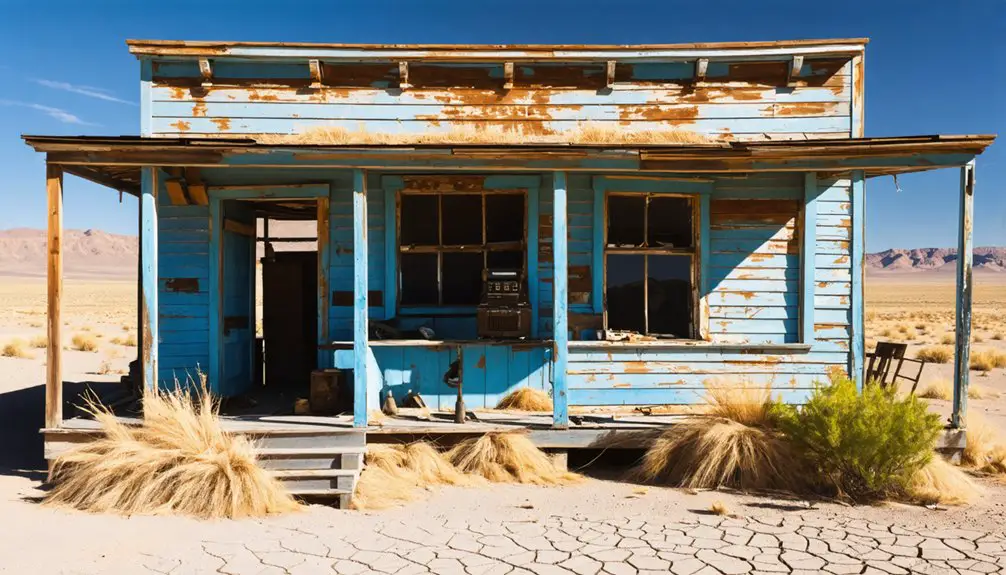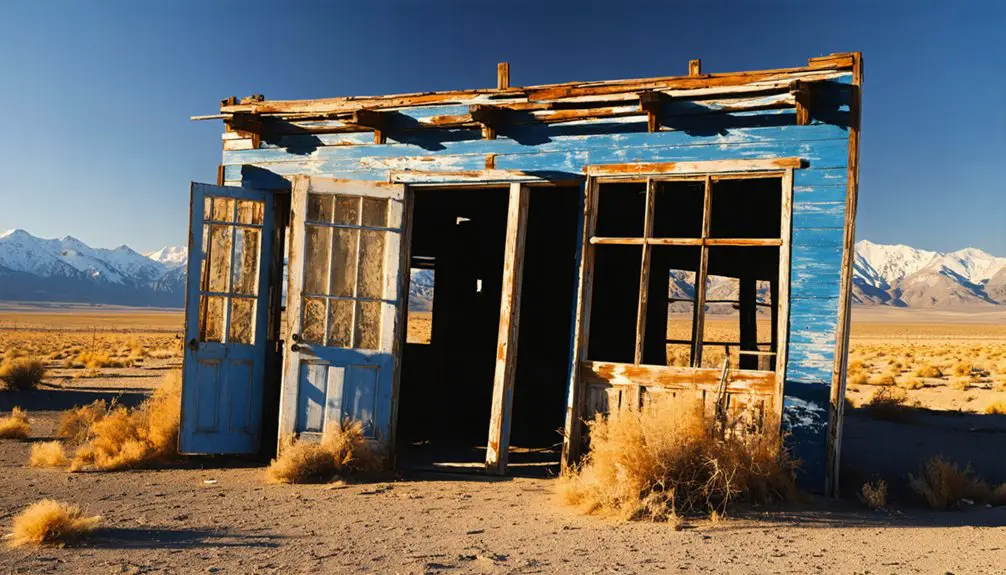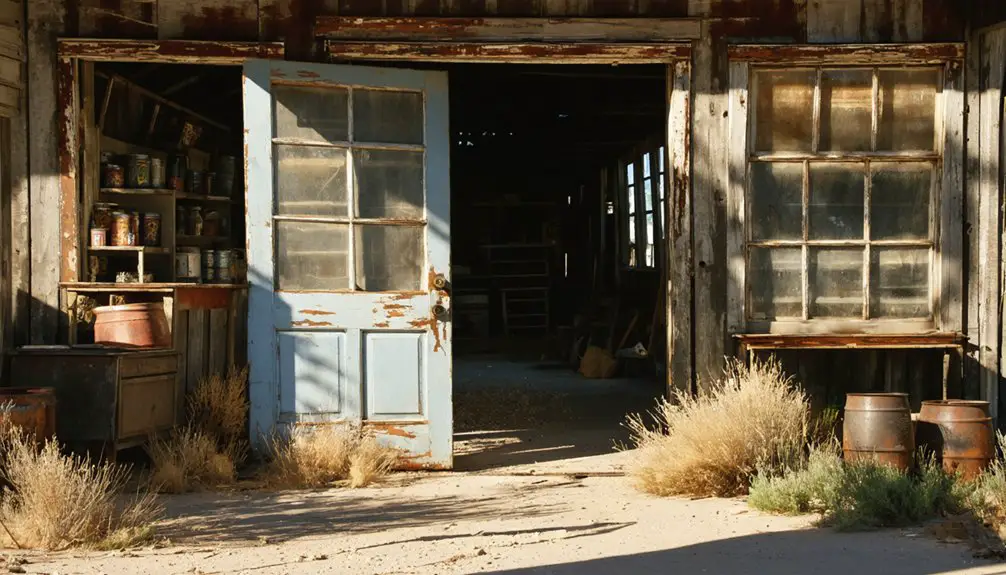You’ll discover Dewey as a fascinating ghost town that emerged in the 1880s along Utah’s Colorado River. Originally named Kingsferry, this frontier settlement served as an essential river crossing point, supporting miners, farmers, and travelers through its ferry service. The community thrived with a post office, school, and halfway house until the 1916 construction of Dewey Bridge shifted its destiny. The site’s remaining foundations, historic fruit trees, and bridge remnants offer glimpses into this once-vibrant transportation hub.
Key Takeaways
- Dewey originated in the 1880s as Kingsferry around Samuel King’s Colorado River crossing, serving miners, farmers, and travelers.
- The settlement featured a ferry service, post office, halfway house, and school until the Dewey Bridge’s construction in 1916.
- The town’s economy centered on ferry operations, which transported people, mail, and supplies across the Colorado River.
- After the bridge replaced the ferry in 1916, Dewey declined as residents relocated to Moab and ferry-dependent businesses closed.
- Today, Dewey’s remnants include building foundations, historic fruit trees, and the original ferry site along the Colorado River.
The Origins of Dewey’s Name
While the town of Dewey, Utah began as Kingsferry in the 1880s, its subsequent name change remains a subject of historical debate. The original name honored Samuel King, who operated a crucial ferry service across what’s now the Colorado River, facilitating regional transportation of cargo, passengers, and livestock.
Dewey’s naming origin presents two competing theories: one credits Dewey Smith, a prospector who camped near the river ford around 1880, while another suggests it came from a supply raft named after Admiral George Dewey. To help readers find accurate information about this naming controversy, Wikipedia maintains a disambiguation page for various Dewey-related topics.
Historical ambiguity persists, as no definitive documentation confirms either story. Though Admiral Dewey’s Spanish-American War fame inspired many Western town names during this era, you won’t find clear evidence linking his legacy directly to this Utah settlement’s renaming. This mirrors the Arizona town of Dewey, which was also named after Admiral Dewey following its earlier identity as Aqua Fria Valley.
Life at the River Crossing
Although Dewey’s remote location posed significant challenges, its position at a crucial Colorado River crossing point transformed the settlement into a vibrant community hub.
The essence of river life centered around the ferry operation, which supported local farmers, miners, and travelers traversing the rugged terrain between Utah and Colorado. Samuel King and Dick Eastwood operated the vital ferry service that connected the isolated communities. Supplies would arrive by rail at Cisco and then be transported by wagon to serve the settlement. Community resilience flourished as settlers established a post office, halfway house, and small school, creating a self-sustaining network despite their isolation.
You’ll find that families adapted to the demanding environment by developing informal support systems that balanced agricultural needs with mining opportunities. The settlement’s strategic location fostered connections through the ferry service, while the surrounding canyon geography, though imposing, provided the foundation for a uniquely connected frontier community.
Ferry Operations and River Commerce
The ferry service at Dewey emerged as the cornerstone of local commerce and connectivity in the 1880s when Samuel King established the first crossing point on the Colorado River.
You’ll find that several operators, including Dick Eastwood and Richard Westwood, managed the crossing through the early 1900s, with George Coombs earning $20 monthly plus tolls in 1909.
The ferry operations supported crucial regional economic activities, particularly silver mining near the Dolores River, while facilitating mail delivery and stagecoach traffic across the waterway.
Martha Westwood’s boarding house served travelers and stage drivers, creating a bustling hub of river commerce. The establishment provided meals for travelers at reasonable prices, becoming an essential stop along the route.
Despite occasional setbacks, like the 1914 incident when the ferryboat broke loose and drifted downstream, the service remained essential until the Dewey Bridge’s completion in 1916. Each ferry trip cost $5 per car with additional passengers riding at no extra charge.
A Hub for Regional Transportation
You’ll find Dewey’s emergence as a transportation hub directly tied to its evolution from ferry crossing to bridge terminus, serving as one of the few viable Colorado River crossing points in southern Utah.
The convergence of pack trails, toll roads, and eventually the Dewey Bridge transformed this remote location into a critical junction connecting Moab, Castle Valley, and western Colorado’s markets. The 1916 suspension bridge became a landmark achievement for regional infrastructure development.
The site’s strategic position, where natural geography permitted river access, established Dewey as an essential link in the region’s transportation network, facilitating the movement of agricultural products, supplies, and travelers across otherwise impassable terrain. Originally shipped in pieces from Chicago by rail, the bridge would become one of the longest suspension bridges west of the Mississippi.
River Crossing Evolution
Located at a strategic point along the Colorado River, Dewey’s river crossing evolved from a primitive ferry operation into an essential transportation hub that transformed regional connectivity in southeastern Utah.
You’ll find that Samuel King’s 1880s ferry crossing marked the first major advancement in river navigation, providing passage for cargo, passengers, and livestock.
When ice sank the ferry in 1913, the incident catalyzed efforts to modernize crossing technology. The change culminated in 1916 with the construction of the Dewey Bridge, a 502-foot suspension bridge that revolutionized regional commerce. The Midland Bridge Company was responsible for this impressive construction project.
This engineering marvel replaced the weather-dependent ferry system, establishing year-round access between southeastern Utah and western Colorado markets, while eliminating the need for challenging alternative routes like the Heavenly Stairway. The bridge was designed to support six horses and wagons, making it the second-longest suspension bridge west of the Mississippi River.
Transportation Networks Converge
From its humble beginnings as King’s Ferry crossing, Dewey emerged as an essential transportation nexus where multiple transit modes converged to serve southeastern Utah’s evolving needs.
You’ll find evidence of this transportation evolution in the integration of ferries, pack trails, and toll roads that eventually gave way to the historic Dewey Bridge in 1916.
The site’s regional connectivity expanded through coordinated rail and road networks, with prefabricated bridge components arriving by train for assembly.
As one of only three Colorado River crossings in the region, Dewey’s strategic location facilitated crucial links between Utah’s remote communities and Colorado’s western markets.
The transportation hub supported diverse cargo movement, from agricultural products to mining outputs, while simultaneously serving travelers through amenities like the halfway house and post office.
The Rise and Fall of a Frontier Town

You’ll find Dewey’s origins in the 1880s when Samuel King established a crucial ferry crossing at the confluence of the Colorado and Dolores Rivers, creating a settlement that served travelers, farmers, and prospectors.
The ferry operation, managed by a succession of operators including Dick Eastwood and Gay Brown, became essential for transporting cargo, passengers, and livestock between isolated communities in eastern Grand County.
The town’s prominence was short-lived, however, as the 1916 construction of Dewey Bridge eliminated the need for ferry services, leading to rapid population decline and eventual abandonment.
Early Settlement and Services
During the 1880s, Dewey emerged as an important frontier settlement around Samuel King’s ferry crossing at the confluence of the Colorado and Dolores Rivers. Originally named Kingsferry, this strategic location offered a rare passage through the steep canyon cliffs, making it essential for regional transportation and commerce.
Richard and Martha Westwood later took over the ferry operations and established settlement services by running a halfway house for weary travelers.
As community growth progressed, you’d have found a small school, post office, and various amenities serving both locals and passersby. The site attracted silver miners, farmers, and families who contributed to the area’s development.
While Dewey never became a large town, its position as a significant river crossing point made it an indispensable hub for southeastern Grand County’s early pioneers.
Ferry Transportation Legacy
The ferry service at Dewey shaped the town’s destiny and pioneering spirit for over three decades. You’ll find that Samuel King’s establishment of the original crossing in the 1880s created essential ferry routes connecting remote Utah communities before modern roads existed.
The operation, run by notable ferrymen like Dick Eastwood and George Coombs, proved fundamental for cargo transport, mail delivery, and passenger service.
While operational challenges persisted, including a dramatic 1914 incident where the ferry broke loose and drifted 15 miles downstream, the service remained critical to frontier life.
The ferry’s significance extended beyond mere transportation – it created a hub where travelers could find lodging at Martha Westwood’s boarding house and connect with stagecoach services to Cisco and Castleton.
This era ended when the Dewey Bridge’s 1916 completion marked the ferry’s obsolescence.
Abandonment After Bridge Construction
When the Dewey Bridge opened in 1916, it triggered a swift and irreversible decline of the once-thriving ferry town.
You’ll find that the bridge’s completion rendered the ferry operation instantly obsolete, setting off a chain reaction of economic decline throughout the community. Local businesses that had supported ferry traffic soon shuttered their doors as travelers and commerce shifted to the new crossing point.
The resulting community displacement was dramatic – residents abandoned their homes and businesses, relocating primarily to Moab where better opportunities awaited.
Without its core ferry-based economy, Dewey’s population dwindled rapidly. What you’ll see today are just ghostly remnants of the former settlement, including an old gas station, standing as silent witnesses to a frontier town that couldn’t survive the march of progress.
Legacy and Present-Day Remnants

Although Dewey’s bustling days as an essential transportation hub have long passed, its legacy endures through physical remnants and historical significance in Utah’s settlement narrative.
Today, historical preservation efforts highlight the town’s importance through educational programs at local museums and onsite exploration opportunities.
You’ll find tangible connections to Dewey’s past through:
- The original ferry site featuring visible structural remnants and an icehouse cave
- Historic fruit trees and building foundations that outline the former settlement
- Rocks inscribed with “Kings Toll Road” marking the original transportation route
- The remains of the 1916 Dewey Bridge, though destroyed by fire in 2008
These physical traces serve as vital learning tools, allowing you to experience firsthand the evolution of transportation and settlement patterns in Utah’s canyon country.
Frequently Asked Questions
What Was the Average Cost of Ferry Tolls in Dewey?
You can’t determine exact ferry operations toll pricing, though regional comparisons suggest you’d likely pay around $0.50 for wagons, $0.25 for extra teams, with varying rates for livestock and passengers.
How Many Permanent Residents Lived in Dewey During Its Peak?
Like a tiny seedling that never reached its full height, you’ll find that without mining industry driving population growth, Dewey maintained fewer than 100 permanent residents during its brief peak years.
Were There Any Notable Accidents or Deaths at the Crossing?
While you won’t find records of notable crossing accidents specifically at Dewey’s crossing, the nearby 1938 South Jordan rail disaster claimed 24 lives and led to significant changes in crossing safety regulations.
What Native American Tribes Inhabited the Area Before Dewey’s Establishment?
You’d find the Ute people were primary inhabitants, with their rich Indigenous history shaping the region’s Cultural impact, while Paiute, Goshute, and occasional Shoshone tribes also traversed these ancestral lands.
Did Any Famous Historical Figures Pass Through Dewey?
You won’t find any famous visitors in Dewey’s historical records. While the town held local historical significance for transportation, it primarily served regional settlers, merchants, and travelers rather than notable figures.
References
- https://en.wikipedia.org/wiki/Dewey
- https://www.heraldextra.com/sanpete-county/2024/jul/24/beehive-archive-ghost-towns-dewey/
- https://moabmuseum.org/dewey-utah-exploring-the-ghost-town-along-the-colorado-river/
- https://utahstories.com/2023/11/ghost-towns-of-grand-county-utah/
- https://www.canyoncountryzephyr.com/2018/06/04/a-history-of-dewey-utah-by-herm-hoops/
- https://www.dhaz.gov/2165/Dewey-Humboldt-History
- https://jacobbarlow.com/2016/05/03/dewey-utah-originally-kingsferry/
- https://www.adventureswithdog.com/2017/07/dewey-bridge/
- https://www.moabhappenings.com/Archives/historic0805DeweyBridge.htm
- https://wayneswords.net/threads/the-last-days-of-the-hite-ferry-and-the-rise-of-highway-95.6719/



